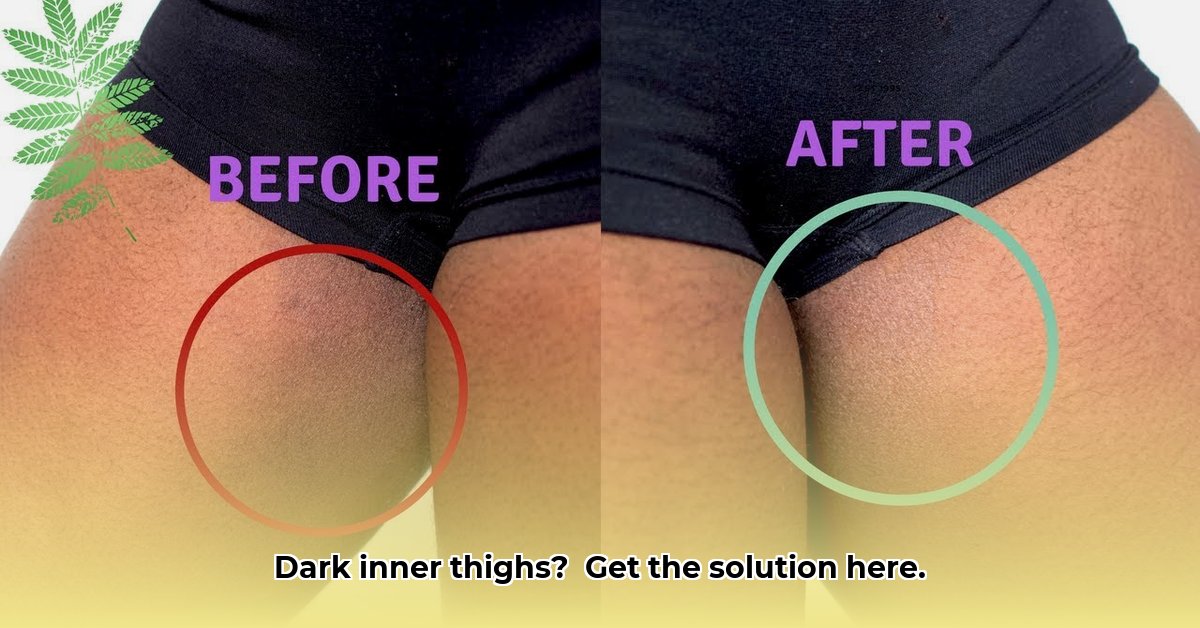# Darkness in Inner Thighs: Solutions & Treatments
<p>Have you noticed darker skin on your inner thighs? It's a common concern, and many people feel self-conscious about it. This article explains the various reasons why it occurs – from simple chafing to hormonal fluctuations and underlying medical conditions. We'll explore effective treatment options, including home remedies, over-the-counter solutions, and professional treatments, along with practical tips to help prevent it from recurring. Whether you're seeking a quick fix or long-term management strategies, we aim to provide the information and advice you need to feel confident and comfortable in your skin.</p>
For similar skin concerns elsewhere, learn about [linea alba](https://chaztin.com/cheek-linea-alba/).
## Understanding Dark Inner Thighs and Finding Solutions
Dark patches on the inner thighs, also known as hyperpigmentation, are a frequent concern for many individuals, regardless of skin tone. While often a cosmetic issue, understanding the underlying causes is crucial for selecting the most appropriate and effective solution.
### What Causes Dark Inner Thighs?
Darkened skin on the inner thighs is typically the result of an overproduction of melanin, the pigment responsible for skin color. Several factors can contribute to this localized hyperpigmentation:
* **Friction:** Persistent rubbing of the inner thighs against each other or against tight clothing can lead to irritation and inflammation, triggering an increase in melanin production. Activities such as exercise, walking, or wearing restrictive clothing can exacerbate this issue. Studies have shown that reducing friction can significantly lighten the affected area.
* **Hormonal Imbalances:** Fluctuations in hormone levels, particularly in women, can contribute to hyperpigmentation. Conditions such as pregnancy, menstruation, and polycystic ovary syndrome (PCOS) can cause hormonal shifts that stimulate melanin production. The precise mechanisms by which hormones influence melanin production are complex and still under investigation.
* **Underlying Health Conditions:** In some cases, dark inner thighs can be a symptom of an underlying medical condition, such as diabetes or acanthosis nigricans (a skin pigmentation disorder often associated with insulin resistance). Consulting a doctor to rule out any underlying health issues is essential for proper diagnosis and treatment.
* **Medications:** Certain medications, including hormonal contraceptives and some chemotherapy drugs, can cause hyperpigmentation as a side effect. Reviewing medication information and discussing potential side effects with a doctor or pharmacist is recommended.
* **Sun Exposure:** Exposure to ultraviolet (UV) radiation from the sun can stimulate melanin production, worsening existing hyperpigmentation. Protecting the inner thighs from sun exposure is crucial in preventing further darkening.
* **Post-Inflammatory Hyperpigmentation (PIH):** Following inflammation, such as eczema or psoriasis, the skin can produce excess melanin, resulting in dark patches.
### Treatment Options for Dark Inner Thighs
The most suitable treatment approach depends on the severity of the hyperpigmentation and the underlying cause. Here’s a breakdown of available options:
**1. Home Remedies: A Conservative Approach**
Home remedies can be effective for mild cases of hyperpigmentation. However, it's essential to manage expectations, as they may not provide dramatic results.
* **Gentle Exfoliation:** Gently exfoliating the area with a mild scrub made of oatmeal or yogurt can help remove dead skin cells and promote cell turnover. Exfoliating too vigorously can worsen irritation, so proceed with caution.
* **Moisturizers:** Keeping the inner thighs well-hydrated can help prevent irritation and promote skin health. Look for moisturizers containing ingredients like vitamin C, which has antioxidant and skin-brightening properties, or aloe vera, known for its soothing effects.
* **Lemon Juice:** Lemon juice contains citric acid, a natural bleaching agent that may help lighten dark spots. However, it can also be irritating to the skin, so it's important to dilute it with water and avoid sun exposure after applying it.
**2. Over-the-Counter (OTC) Creams: A Moderate Approach**
OTC creams containing ingredients such as kojic acid, arbutin, azelaic acid, or niacinamide can help lighten dark spots. These ingredients work by inhibiting melanin production. However, their effectiveness varies, and some individuals may experience side effects such as skin irritation or allergic reactions. Performing a patch test before applying the cream to a larger area is recommended.
**3. Prescription Options: A Stronger Approach**
If home remedies and OTC products are ineffective, a dermatologist can prescribe stronger treatments, such as:
* **Retinoids:** Topical retinoids, derived from vitamin A, can promote skin cell turnover and reduce hyperpigmentation. They can also increase skin sensitivity to the sun, so sunscreen is essential.
* **Hydroquinone:** Hydroquinone is a potent skin-lightening agent that inhibits melanin production. However, it can cause skin irritation and may have potential long-term safety concerns. Dermatologists typically prescribe hydroquinone for short-term use under close supervision.
* **Chemical Peels:** Chemical peels involve applying a chemical solution to the skin to remove the outer layers, revealing brighter skin underneath. They can be effective for treating hyperpigmentation but can also cause redness, peeling, and irritation.
**4. Medical Procedures: An Advanced Approach**
In severe cases of hyperpigmentation, a dermatologist may recommend medical procedures such as:
* **Laser Treatments:** Laser treatments use focused light energy to target and destroy melanin-producing cells, reducing hyperpigmentation. Different types of lasers are available, and the choice depends on the individual's skin type and the severity of the hyperpigmentation.
### Choosing the Right Treatment Path
Selecting the most appropriate treatment depends on individual factors such as skin type, the severity of hyperpigmentation, underlying causes, and personal preferences. Consulting a dermatologist is recommended to determine the best course of action.
### Comparing Treatment Options
| Treatment Option | Effectiveness | Side Effects | Cost |
|--------------------------|----------------------|-------------------------------------|-----------------|
| Home Remedies | Low | Minimal | Very Low |
| OTC Creams | Variable | Potential skin irritation, allergies | Low to Moderate |
| Prescription Retinoids | Moderate to High | Skin irritation, sun sensitivity | Moderate |
| Hydroquinone (Rx) | High | Skin irritation, potential safety concerns | Moderate |
| Chemical Peels | Moderate to High | Redness, peeling, irritation | Moderate to High |
| Laser Treatments | Very High | Redness, swelling, hyper/hypopigmentation | High |
Consistency and patience are crucial for achieving optimal results with any treatment option. Regular checkups with a dermatologist can help monitor progress and adjust the treatment plan as needed.
## Treating Dark Inner Thighs from Friction and Hormonal Imbalance
### Understanding the Causes: Friction and Hormones
Darkening of the inner thighs often results from friction and hormonal imbalances, leading to increased melanin production in the affected area.
* **Friction:** Constant rubbing of the inner thighs, caused by tight clothing, exercise, or walking, can irritate the skin and trigger hyperpigmentation.
* **Hormonal Imbalances:** Hormonal fluctuations during pregnancy, menstruation, or due to conditions like PCOS can stimulate melanin production, contributing to dark inner thighs.
### A Multi-Pronged Treatment Approach
Treating dark inner thighs resulting from friction and hormonal imbalances requires a comprehensive approach that addresses both the underlying causes and the resulting hyperpigmentation.
**1. Preventative Measures:**
* **Wear Loose, Breathable Clothing:** Opt for fabrics like cotton that allow the skin to breathe and reduce friction.
* **Maintain a Healthy Weight:** Reducing excess weight can decrease friction between the inner thighs.
* **Keep the Area Clean and Dry:** Regularly cleanse and thoroughly dry the inner thighs to prevent irritation and infection.
* **Moisturize Regularly:** Hydrated skin is less prone to irritation and hyperpigmentation.
* **Use Sunscreen:** Protect the inner thighs from sun exposure by applying sunscreen with an SPF of 30 or higher.
**2. Over-the-Counter (OTC) Treatments:**
OTC creams and lotions containing the following ingredients can help fade hyperpigmentation:
* **Niacinamide:** Known for its anti-inflammatory and skin-brightening properties, niacinamide can help reduce hyperpigmentation and even out skin tone.
* **Alpha Hydroxy Acids (AHAs):** AHAs, such as glycolic acid and lactic acid, exfoliate the skin, removing dead cells and promoting cell turnover.
* **Kojic Acid:** Kojic acid inhibits melanin production and can help lighten dark spots.
**3. Home Remedies:**
Some home remedies may help soothe irritated skin and promote lightening:
* **Aloe Vera:** Aloe vera has anti-inflammatory and soothing properties that can help reduce irritation and promote healing.
* **Oatmeal Baths:** Oatmeal baths can help soothe irritated skin and reduce inflammation.
4. **Professional Treatments:**
A dermatologist may recommend professional treatments such as chemical peels or laser therapy for more stubborn cases of hyperpigmentation. These treatments can provide more dramatic results but may also have potential side effects.
Latest posts by Chaztin Shu (see all)
- Mini Bento Boxes For Packing Kids Snacks And Small Meals - December 27, 2025
- Small Bento Box Makes Packing Lunch Easy and Fun Again - December 26, 2025
- Adult Bento Box Lunch Ideas For Quick Healthy Portable Options - December 25, 2025










